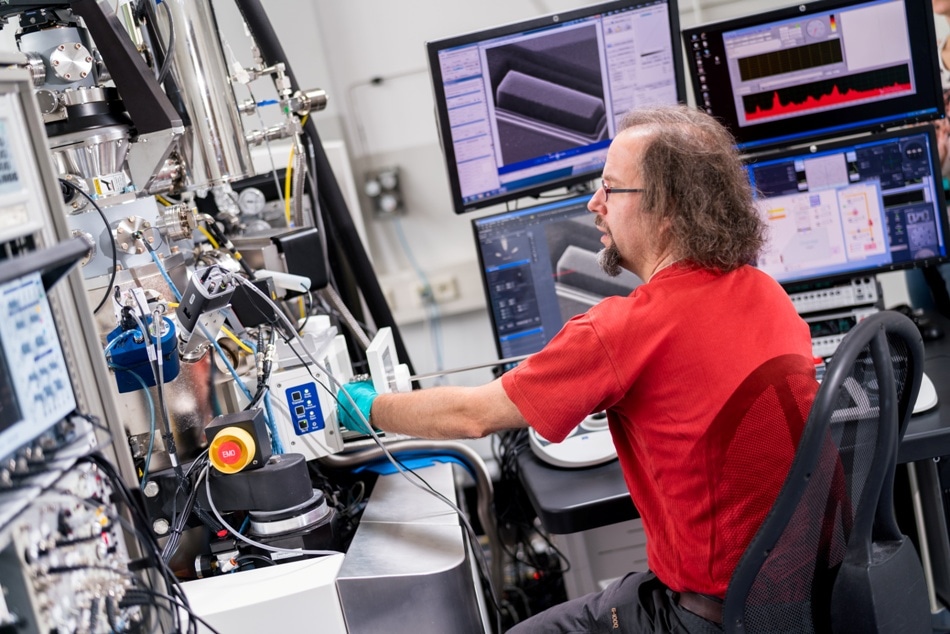Nov 13 2019
A research team has been working to create engineered magnetic nanostructures and to customize the properties of materials at the nanoscale. The team includes physicists from Helmholtz-Zentrum Dresden-Rossendorf (HZDR)—a German research center—and collaborators from the University of Glasgow and the Leibniz Institute for Solid State and Materials Research Dresden (IFW).
$ Physicist Dr Gregor Hlawacek coordinates the experiments at the helium-ion microscope of the Helmholtz-Zentrum Dresden-Rossendorf (HZDR). Image Credit: HZDR/A. Wirsig.
Physicist Dr Gregor Hlawacek coordinates the experiments at the helium-ion microscope of the Helmholtz-Zentrum Dresden-Rossendorf (HZDR). Image Credit: HZDR/A. Wirsig.
To achieve this objective, the researchers used a unique microscope at the HZDR Ion Beam Center. The ultrathin ion beam of this microscope can create stable and periodically assembled nanomagnets in a sample material. In addition, the microscope can be utilized to improve the magnetic characteristics of carbon nanotubes. The scientists have currently reported their results in two articles published in Small journal.
“The magnetic tuning of materials in the nanometer range offers great potential for the production of state-of-the-art electronic components. We pursue various approaches with regard to our magnetic nanostructures, all of which involve the use of ion beams,” stated Dr Rantej Bali, Dr Kilian Lenz, and Dr Gregor Hlawacek, all researchers from HZDR.
For instance, focusing an ion beam at a non-ferromagnetic iron-aluminum alloy can dislodge a few hundred atoms. The alloy contains atoms that subsequently rearrange and thus increase the number of neighboring magnetic iron atoms. Consequently, a magnet is created within the area of the site of bombardment.
This method allowed the scientists to embed the nanomagnets locally in thin films of a material; this material was originally non-ferromagnetic.
Disorder Induces the Incorporation of Nanomagnets
The HZDR researchers demonstrated in their latest study that the disorder induced by the ion beam also raised the volume of the underlying lattice structure, although unevenly in all spatial directions. Moreover, the magnetic behavior is also affected by the lattice distortion.
For example, the magnetization in an elongated magnetic stripe is anticipated to align along the long axis, as is usually the case in a traditional bar magnet. But since the embedded nanomagnets have lattice distortion, transverse magnetization components are also seen.
The overall impact is that the magnetic moments are likely to “bend” away from the length of the magnet in a periodic manner. These magnetic domains are stable and periodically arranged and can also be formed reliably in curved magnets. They may have potential applications in tiny magnetic sensors, for instance.
The physicists used noble gases in the HZDR helium-ion microscope to create very thin and thus extremely accurate ion beams.
The diameter of our ion beam is just a few atoms wide. Depending on which noble gas is used, we can then modify the properties of the irradiated material or change its morphology by removing atoms.
Dr Gregor Hlawacek, Researcher, HZDR
Hlawacek manages the experiments at the helium-ion microscope.
In spite of its name, the helium-ion microscope is not simply restricted to helium alone. In their recent experiments, the scientists utilized neon, which is known to be heavier than helium and has a stronger effect on the material to be altered.
Furthermore, cooperation with the University of Glasgow allowed the HZDR team to utilize the transmission-electron microscope situated at its Chair of Material and Condensed Matter Physics.
The experiments performed by Rantej Bali involved the use of a neon ion beam as a magnetic writing stylus.
The ion beam enables magnetic nanostructures to be produced in any shape or form, which are embedded in the material and defined solely by their magnetic and crystallographic properties.
Dr Rantej Bali, Researcher, HZDR
Dr Bali summed up the outcomes of his earlier study, performed at the HZDR as part of a DFG project.
Using Neon Ions to Trim Materials
On the other hand, Kilian Lenz applies the technique of focused ion beam manipulation to improve the preferred material characteristics by altering the shape of the nanostructure itself. The diameter of the neon ion beam is just 2 nm. At the site of bombardment, material unevenness, or just material edges, is eliminated in equal dimension.
“We examine this using carbon nanotubes containing an almost cylindrical magnetic iron core. The structure and geometry of these nanotubes can be optimized by trimming in the helium-ion microscope,” said Lenz, elucidating the process.
Using a micro-manipulator, a single tube—with a length of 10 µm and a diameter of 70 nm—is separated and placed in a microresonator for measurement.
It is an extremely elaborate process that the team from the Leibniz Institute for Solid State and Materials Research Dresden has developed for us.
Dr Kilian Lenz, Researcher, HZDR
The unusual combination of cuts, utilizing the focused ion beam as well as the measurements of the iron core’s ferromagnetic resonance, allows the scientists to shed light on an almost perfect magnetic structure to expose the characteristics of the iron core in the nanotube. The researchers were headed by Lenz.
Such techniques for the targeted manipulation of the properties of nanomagnetic materials using focused ion beams will continue to be investigated at the Institute of Ion Beam Physics and Materials Research of HZDR in the days to come.
According to the researchers, their technique and the modified materials it creates have the potential for advancing spintronic applications and aid in producing novel sensing devices or storage media.